#western thor
Text


tragically i don't have time to do full art for the yeehaw challenge so instead. doodles 🤠
day 1: ✨gather the posse ✨
#is this comics? is this mcu? FALSE it is a secret THIRD thing: a western#also uhhhhh cowboys. are frequently secretly fond of each other. tony#yeehawgust#CLINT GETS A MOUSTACHE BC I AM UNKIND TO HIM <3#also tony & steve definitely have matching red bandanas however he needed the blue somewhere and i didnt want 2 colour the vest#so here we are#also in the secret western avengers that lives in my head. thor is still a norse god hes just also wearing a poncho. 4 the bit
204 notes
·
View notes
Note
is it weird that i like thorki… but sylki makes me wanna throw up ,,?? 💀
hmmmmm premium, juicy sirloin steak cut vs mcdonald's patty
#this is said in good fun#i need to clarify because otherwise it's going to come across as bad from a western perspective where low quality is more accessible/cheap#or like because what if anon is a vegetarian#also i have nothing against sylki but think a lot of people are doing it wrong and also i find thorki hilarious bye#the Loki show#fr tho Loki and Thor have like thousand years together and were established with a thoroughly complex relationship#Loki has known Sylvie for like. a day? It's like Jane/Thor from a thorki perspective like my dude it'll never stop being funny#''Loki's fallen in love with blonde Loki who is aggressive and not Loki and parallels a lot of Loki's family dynamic scenes!'' ...ok.......#like ur telling me she killed a bunch of people violently is blonde and loki fell in love instantly? bestie that's not ur girl that's thor#Thor ''my type is curious intelligent women with dark hair who will hit me. any eye colour will do. must be ok with roleplay'' Odinson#thorki#Thor/Loki#Sylvie/Loki#sylki
56 notes
·
View notes
Text
has taika made a queer cowboy media yet??? I just think he could have the quadrafecta of making things that are already gay even more gay
#rosi shitposts#hes done vampires and pirates and the norse gods#i want a taika western pls#what we do in the shadows#our flag means death#thor ragnarok#thor love and thunder#marvel#mcu#queer#gay#taika waititi
65 notes
·
View notes
Text
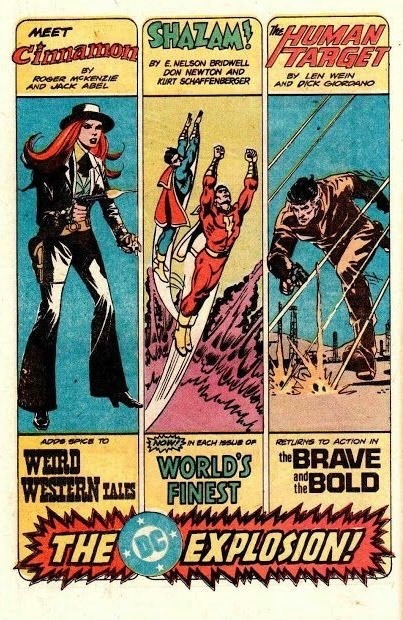

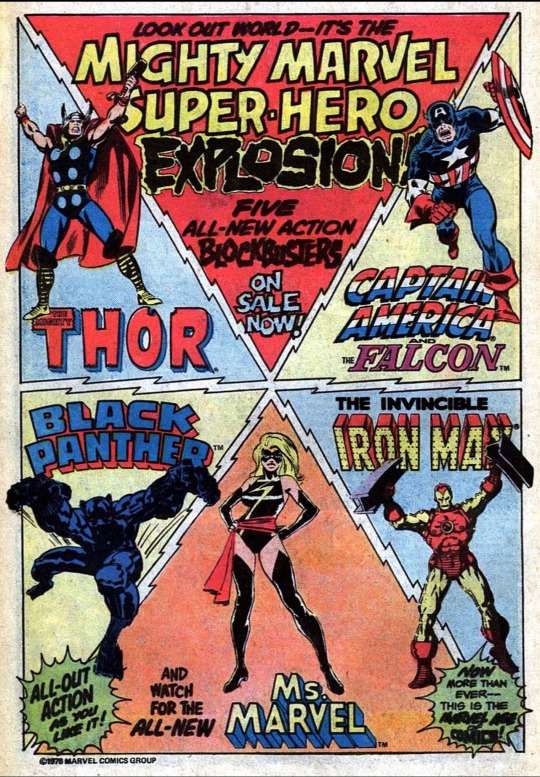

Comic book advertisements from the Bronze Age
#comic book ads#marvel comics#dc comics#bronze age#weird western tales#world's finest#the brave and the bold#thor#black panther#ms. marvel#captain America and the falcon#the avengers#the defenders#x men#the invaders#fantastic four#1970s
7 notes
·
View notes
Text
Started watching Walker Independence with my dad and by episode 3 I'm of course shipping the main love interest with the man who's gonna steal HIS girl because as my friend stated "cowboys are inherently gay" AND they're hot men so like 🤷🤷🤷 what else was my gay lil brain supposed to do?
#walker independence#hoyt#calian#what would their ship name be?#coyt?#holian?#halian?#hoylian?#idk I'm making shit up at this point#which in the words of Thor: all words are made up so 🤷#cowboys and indians#western
4 notes
·
View notes
Text

╰┈➤ storm prompts / @yendarxenk / accepting !
❝ We’re going to catch colds if we stay out here. ❞
𝐋𝐈𝐏𝐒 𝐏𝐑𝐄𝐒𝐒𝐄𝐃 𝐈𝐍𝐓𝐎 𝐀 𝐓𝐇𝐈𝐍 𝐋𝐈𝐍𝐄 𝐁𝐄𝐅𝐎𝐑𝐄 , in mute admonishment , thor let out a soft huff of dry laughter. that HE , the mighty thor , would catch something so trivial as fever from his most dear of heralds. ( SUCH THOUGHT WAS MERE FOLLY. ) ...such thought was , unfortunately , perfectly logical.
thor did not know the limits of this human form. and though it was beyond his normal strength to resist such afflictions , his father's enchantments had always been THOROUGH. he was no more aesir than the goats that grazed the fields. ( what an insult to the goats. )

with some effort he transformed his incredulity into gratitude. for who was thor to scorn a simple warning? an act of goodwill?
❝ so it would seem. i believe the settlement called vesper town is to the east of us from here. should we hurry , we may just make it to shelter before the storm thickens. ❞
#(//quietly puts them in the western fanalean fields --> linked in vesper town <--- for funsies)#(thor was probably expecting to go to the farmlands but didn't make it in time before the storm got to him first u.u)#(he feels strange having to /avoid/ the storm instead of revel in it for his health it's normally the opposite!)#( ic . ) — son of odin . the crown is a heavy burden for thee .#( answered . ) — black feathers fall to a raven's call .#yendarxenk
1 note
·
View note
Text
Into the wild
Credits
dust bunny . blackwater decor . hats . mixed @ Anthemdust bunny . blackwater decor . hide rug . cream @ Anthemdust bunny . blackwater decor . guitar . natural @ Anthemdust bunny . blackwater decor . bag . cream @ Anthemdust bunny . desert dreams cacti . fatpack . boxed..::THOR::.. Beach Towel – Cacti..::THOR::.. Essentials Purse – SummerPitaya – Wild relics – Fatpack @ Anthem ❤Pitaya –…

View On WordPress
#Anthem#atelier burgundy#decor#decoration#dust bunny#eloen&039;s other world#North Oak#Pitaya#releases#sl#THOR#western
1 note
·
View note
Photo
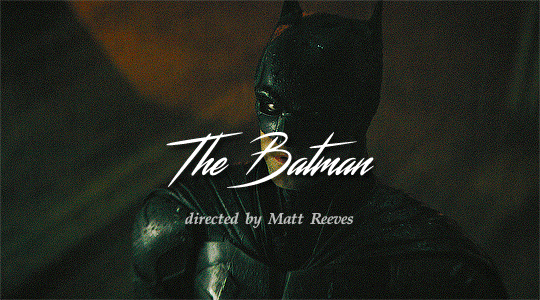



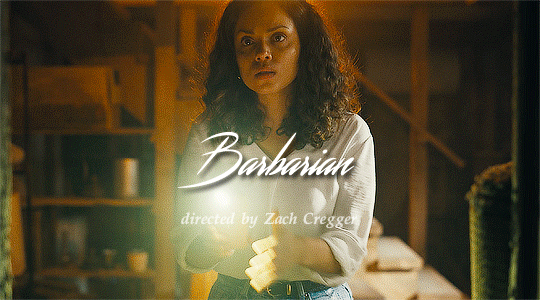



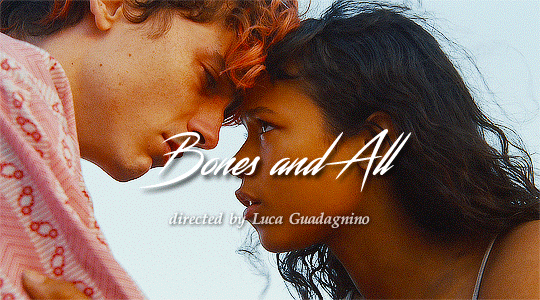


LETTERBOXD
1. The Batman
2. Everything Everywhere All at Once
3. Prey
4. Triangle of Sadness
5. Barbarian
6. The Northman
7. Bodies Bodies Bodies
8. The Banshees of Inisherin
9. Bones and All
10. Avatar: The Way of Water
Grade A
11. Turning Red
12. The Menu
13. Babylon
14. Hit the Road
15. Cow
16. Watcher
17. Funny Pages
18. Mad God
19. On the Count of Three
20. Armageddon Time
21. Terrifier 2
22. Marcel the Shell with Shoes On
23. Smile
24. Glass Onion: A Knives Out Mystery
25. Holy Spider
26. Aftersun
27. The Fabelmans
28. Breaking
29. Decision to Leave
30. The Whale
31. All Quiet on the Western Front
32. Brian and Charles
33. Piggy
34. Saint Omer
35. Thirteen Lives
36. Men
37. The Fallout
38. Resurrection
39. Causeway
40. The Black Phone
41. Official Competition
42. Nope
43. Guillermo del Toro’s Pinocchio
44. Apollo 10½: A Space Age Childhood
45. Till
46. TÁR
47. Happening
48. A Love Song
49. The Outfit
50. The Innocents
51. Jackass Forever
52. BARDO, False Chronicle of a Handful of Truths
53. Montana Story
54. Three Thousand Years of Longing
55. You Won’t Be Alone
56. The Sadness
57. Halloween Ends
58. Pearl
59. X
60. Vesper
Click "Keep Reading” For My Full List
Grade B
61. This Place Rules
62. Fresh
63. Windfall
64. Kimi
65. No Exit
66. Top Gun: Maverick
67. “Sr.”
68. Farha
69. The Unbearable Weight of Massive Talent
70. Weird: The Al Yankovic Story
71. Nitram
72. Speak No Evil
73. Run Sweetheart Run
74. She Said
75. White Noise
76. Puss in Boots: The Last Wish
77. V/H/S/99
78. The Wonder
79. Women Talking
80. Hatching
81. Soft & Quiet
82. Scream
83. To Leslie
84. Hustle
85. Chip ’n Dale: Rescue Rangers
86. Dual
87. God’s Country
88. Emancipation
89. Vengeance
90. Fire of Love
91. Bullet Train
92. Incantation
93. The Valet
94. Hellraiser
95. Christmas Bloody Christmas
96. Significant Other
97. Cha Cha Real Smooth
98. Lucy and Desi
99. Not Okay
100. A Christmas Story Christmas
101. Blonde
102. Deadstream
103. Sissy
Grade C
104. The Bad Guys
105. The Cursed
106. Empire of Light
107. A Man Called Otto
108. Broker
109. Black Panther: Wakanda Forever
110. The Princess
111. Beast
112. After Yang
113. RRR
114. Fall
115. Jackass 4.5
116. Beavis and Butt-Head Do the Universe
117. Doctor Strange in the Multiverse of Madness
118. Jennifer Lopez: Halftime
119. Lightyear
120. The Pale Blue Eye
121. The Woman King
122. Violent Night
123. God’s Creatures
124. Ambulance
125. Elvis
126. You Are Not My Mother
127. Emily the Criminal
128. Crimes of the Future
129. The Apology
130. The Lost City
131. Wendell & Wild
132. Trainwreck: Woodstock ’99
133. The Found Footage Phenomenon
134. See How They Run
135. Spiderhead
136. Studio 666
137. Bros
138. Spin Me Round
139. We’re All Going to the World’s Fair
140. Paws of Fury: The Legend of Hank
141. Honor Society
Grade D
142. Thor: Love and Thunder
143. Summering
144. Strange World
145. Glorious
146. The Gray Man
147. Devotion
148. Clerks III
149. The Forgiven
150. Enola Holmes 2
151. Father Stu
152. Jurassic World Dominion
153. DC League of Super-Pets
154. She Will
155. The Bob’s Burgers Movie
156. Whitney Houston: I Wanna Dance with Somebody
157. Hellbender
158. Samaritan
159. Day Shift
160. Sonic the Hedgehog 2
161. Prey for the Devil
162. Troll
163. Uncharted
164. Lyle, Lyle, Crocodile
165. Dashcam
166. Firestarter
167. Do Revenge
168. Catwoman: Hunted
169. The Munsters
170. Amsterdam
171. Fantastic Beasts: The Secrets of Dumbledore
Grade F
172. Mrs. Harris Goes to Paris
173. The Bubble
174. Dead for a Dollar
175. Jerry & Marge Go Large
176. Honk for Jesus. Save Your Soul.
177. Infinite Storm
178. Marry Me
179. Don’t Worry Darling
180. Spirited
181. Disney's Pinocchio
182. Alice
183. Black Adam
184. Orphan: First Kill
185. The Adam Project
186. The Invitation
187. Texas Chainsaw Massacre
188. Ticket to Paradise
189. The 355
190. Umma
Bottom 10
191. Green Lantern: Beware My Power
192. Deep Water
193. Where the Crawdads Sing
194. Blacklight
195. Mack & Rita
196. Memory
197. Me Time
198. Death on the Nile
199. Morbius
200. Moonfall
#kane52630#filmedit#top 10 2022#top 10 year#filmgifs#doyouevenfilm#fyeahmovies#moviegifs#cinemapix#dailyflicks#chewieblog#userrobin#userbrittany#mikaeled#useroptional#userlera#userkd#dailytvfilmgifs#userel#userconstance#gifs#the batman#everything everywhere all at once#prey#triangle of sadness#barbarian#the northman#bodies bodies bodies#the banshees of inisherin#bones and all
2K notes
·
View notes
Text

LET’S TALK ABOUT EXPLORING LOKI & MOBIUS THROUGH THE LENS OF QUEER EXPERIENCE
Thank you for this request, @nabananab
Before I dig into this juicy ask, I think it’s important to note (however obvious the fact maybe) that an individual’s unique engagement with art is an inherent and integral part of art. The intention of the artist and the sociopolitical influence of culture, while important in our interpretation of a work, are not the sole source of drawing the work’s meaning. We are all artists in one form or another. I consider myself one of the pen, and nothing is more important to me than art giving someone a sense of emotional connection. I should hope other artists would agree, and for this reason I am an ardent believer in art taking on a life of its own once it has been created. The creator’s word, while it matters to some degree, does not supersede an individual’s relationship with the creation. Our histories, our desires, our fears, our likes, our dislikes, indeed our infiniteness as fragile human beings, allow us to create an elevated, spiritual interpretation beyond the confines of original intent. With art, there is no such thing as “reaching” or “reading too deeply”.
I leave this message with all of you as we look at these beloved characters through the lens of queer experience.
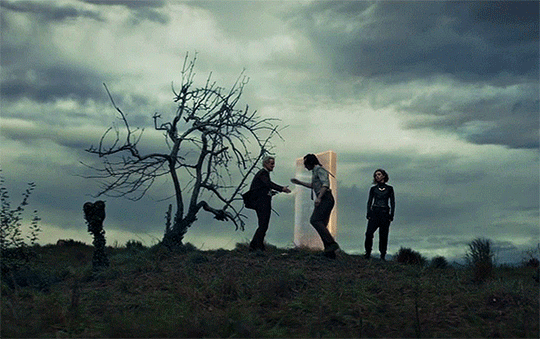
LOKI
Culture influences what we see and hear, which in turn influences artistic portrayal. Setting aside Norse myth, Marvel’s Loki is a classic example of a queer-coded villain (later canonized as a queer antihero). Deception, daggers, sexual temptation, transformation, and magic are all culturally tied to the “immoral” facets of femininity. Just as a strong, independent woman untethered to the control of man is deemed a “wicked woman”, a man demonstrating gender ambiguity and like qualities is similarly judged. Only masculinity is viewed as pure and good, and this no doubt was—and continues to be—a key force in white, western colonization’s destructiveness. It all but crushed our rich global history of divine femininity, gender diversity, and romantic and sexual expression.

Asgard, as Marvel portrays it, is without a doubt a masculine-dominant warrior society. Only two women feature prominently: Queen Frigga and Lady Sif. Whereas Sif embraces her masculine qualities and fits in easily with Thor and the Warriors Three, Queen Frigga embraces her feminine powers, though her authority is submissive to the All-Father, Odin. Her influence is most heavily seen in her adopted son, Loki, with whom she shared and taught magic in hopes that Loki might “feel some sun on himself” despite the “long shadows [Thor] and [Odin]” cast. The magic that Frigga gifts Loki, however, attracts scorn. The subtext here is that Loki’s specialness, his individuality, comes from feminine powers despite presenting as a man, and a gender ambiguous one at that. Unlike Thor and Odin, he is not masculine. While strong, he does not exhibit Thor’s brute strength. He is cautious, thoughtful, another feminine quality, whereas Thor’s courageousness often veers toward foolhardy and brash.
Thus, if Loki cannot be loved and accepted as he is (a queer person of another race), he will force love and acceptance through the power of the throne. Kings oft inspire fear, coercing subjects to love them whether they wish to or not. But we know Loki never truly wanted the throne. The throne is a mere distraction from, perhaps even a poor replacement for, what he truly wants: genuine love and acceptance that cannot be bought. Unfortunately, Loki believes he will never get these things, which is why, when Mobius questions him, Loki’s desire for control (Loki, King of the Midgard; Loki, King of the Nine Realms; Loki, King of Space) can never be satiated. Mobius challenges Loki for the exact purpose of revealing this to him. What do you really want? At this point, Loki does not have the words to form an answer. In S2E5, Syvlie raises the question Mobius originally asked in S1E1. It is then, after experiencing Mobius’s friendship and the other relationships that come to being as a result (including Sylvie’s), that Loki can articulate his answer.
Loki’s othering, even before the discovery of his true identity as a Jotun (an allegory for a villainized foreign race), creates a lonely environment in which Loki’s potential for goodness is quashed by centuries of resentment, bitterness, and jealousy. His attempts at masculinity take the form of violence, all of which are, as Loki admits in S1E1, “part of the illusion; the cruel elaborate trick conjured by the weak to inspire fear.”
Loneliness and the desire for love and acceptance are a universal human experience, but they are felt far more acutely within our intersectional queer communities.
MOBIUS
His fascination with Loki is compelling because there are many things we can infer about its reasons. The first, most obvious explanation is Mobius’s “soft spot for broken things”, which is in some ways tied to his qualities as a compassionate, forgiving, and supportive father. A secondary explanation is a wish for partnership. We know from S1 that Mobius’s friendship with Ravonna spanned eons. We later learn in S2E6 that he and Ravonna started out as peers, hunters. They were partners on the field, but where Mobius “failed” because of his humanity, Ravonna “advanced” because of her ruthlessness. This change in relational dynamics left him partner-less. Finally, a third, less obvious reason is Mobius’s desire to express himself in ways Loki does so effortlessly. That desire may come from the suppression and repression of his own softspoken queerness in order to survive the fascist culture of the TVA.
Mobius is captivating for many reasons. Whereas Loki is a textbook example of culture viewing “queerness as evil”, “queerness as flamboyance”, “queerness as stylishness”, “queerness as loudness”, “queerness as sexual promiscuity and deviance”, “queerness as chaos”, Mobius very much aligns with the image of a straight-passing, repressed queer individual. This is an identity that does not get as much attention or presence in artistic media as it deserves, for there are many who need this representation to reflect them. He is not stereotypically queer by any means: he is not colorful. He is not stylish, flamboyant, or loud. His sex appeal primarily derives from the viewers’ attraction to his personality, though it certainly helps that Owen Wilson is quite handsome.
Combine these three reasons, and it becomes easy to see how a character (or person!) like Mobius might fall in love with a character (or person!) like Loki.
There is a certain amount of beautiful irony in how Loki and Mobius affect one another and consequently their identities. Mobius, feeling compassion toward an individual who has been brutally othered and oppressed, seeks to free Loki from the confines of his narrative, as determined by the “Time Keepers”. The only feasible way to do this is to bring a variant of Loki out of the timeline and into the TVA. Mobius then provides Loki with the opportunity to change by: acknowledging Loki’s strengths, giving Loki the chance to use his strengths in productive ways, praising Loki when he does well, listening to Loki, believing in Loki, calling out Loki, and accepting Loki as he is, with all his history, without judgement. Mobius does not try to force change like Thor or Odin. Rather, he creates an environment in which change could happen naturally. This kindness and, indeed, what becomes unconditional love by the end of S1E4, allows Loki to embrace his authentic queerness with self-love and use his feminine powers for altruism rather than masking them with self-hatred and masculine rage.
FREEING LOKI
In S1E1, Mobius is enthralled with Loki’s hijinks as the handsome, charming, devil-may-care, D.B. Cooper. This minor escapade in Loki’s life, which was likely only intended for laughs by the writer, reveals something interesting about Mobius: Loki’s mischievousness, his magic, his cunning, are all quite endearing to him when no real harm is being inflicted. That is, Loki, when not under duress, is someone to be admired when he’s being himself. We admire in people what we wish we had in ourselves, and this, at times, may lead to powerful attraction.
Loki, for his part, does much the same for Mobius. The environment (the TVA) which allowed Loki to thrive is also the same environment that has abused and constrained Mobius.
The heat that Ravonna presses upon Mobius, however, changes his tone with Loki himself. When Loki asks Mobius why he “[sticks] his neck out for [him]”, Mobius provides Loki with two options to choose from: “A. He sees a scared little boy shivering in the cold, or B. He will say whatever he needs to say to get the job done”. Option A, while insulting, has compassion layered beneath the barb. Loki, an expert at cloaking truth with meanness, sees through this and indirectly chooses what he believes to be true in the cafeteria scene: that Mobius feels sympathy for Loki’s painful childhood. The subtext of this acknowledgement is that the true means to the end is reversed: Mobius doesn’t need Loki to catch the Variant on the timelines. Mobius needs the Variant to free Loki from the timelines. The Variant is an excuse and another agent of poetic irony: when Sylvie unleashes the multiverse, she literally frees Loki of his predetermined narrative.
The conceit of S1E1 is that Mobius intends to use Loki for the “good” of the Sacred Timeline. It is important to remember that characters, while not real, are meant to mirror human complexity. Multiple, seemingly conflicting things may be true concurrently. In S1E2, we see in Mobius’s conversations with Ravonna that he deeply believes in Loki’a capacity to be a wonderful person and wants him to have the opportunity to change. His enthusiasm for these things outshines his desire to catch Sylvie.

And, because the Variant is Loki, because Sylvie is Loki, because, as she says, “[they] are the same”, Mobius’s own freeing of Loki, his unconditional love for him, cascades from Loki to Sylvie. Sylvie would not be free to live as she pleases if not for Mobius’s compassion for Loki in the first place.
In S1E4, Loki reveals the TVA’s sham. Mobius’s sense of self becomes fragile alongside his sense of partnership with Loki. But because of our sociopolitical culture’s influence on capitalism, the creative voices of the Loki series self-censures what could be (what is) a queer romance. This self-censureship makes itself known in Mobius’s own self-censureship. His jealousy and heartbreak cannot be spoken directly. It must be spoken through the words of a woman, someone who presents as the opposite sex. Through a looping memory of a scornful Sif telling Loki, “You are alone and always will be”, Mobius makes known the nature of his feelings for him.
BUT WHO WILL FREE MOBIUS?
In the same cafeteria scene in S1E2, Loki asks Mobius if he’s ever ridden a jet ski. Mobius’s response is demure, saying him riding one would “cause a branch for sure”. The jet ski gives the audience another clue as to what Mobius seeks in life: something fun, thrilling, and reckless. Yet Mobius sets aside his desires for what he believes is for the good of the TVA, and thus humanity. This suppression and repression of authentic selfhood mirrors the queer experience of living within a heteronormative culture, especially one with religious doctrines that equate pleasure with sinfulness.
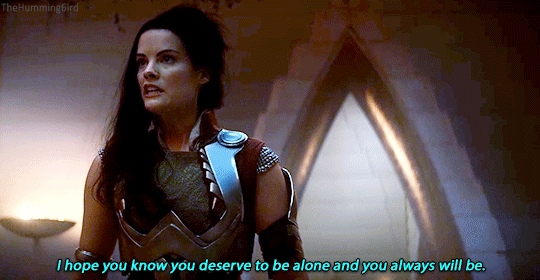
Because Mobius extended his heart, his partnership, his love (symbolized by twin daggers hidden in his locker [a closet]; notably a male phallic symbol of which there are a pair [partners]) and was soundly rejected, Mobius retaliates with the loneliness he himself feels. This loneliness may be interpreted as an allegory for the loneliness of being closeted as opposed to the loneliness of being out but othered.

Ultimately, Mobius’s love for Loki shifts from selfish desire to unconditional love when he chooses to help Loki save Sylvie. In S1E5, it is conspicuous that after delivering Sylvie safely to Loki’s side, Mobius’s partings words are, “Guess you got away again”, to which Loki replies, “I always do”, which echos the lover’s trope of “the one that got away”.
[It drives me absolutely bananas that I can't find the specific gif I need when I literally saw it multiple times earlier this week but didn't need it THEN]
Owen’s acting choice is interesting here. He laughs, smiles, then looks down before looking up again, his eyes shifting from fondness to what feels like longing. Mobius extends his hand, a sensible choice for someone who believes his love is unrequited and is unsure of how Loki defines their relationship. Loki, appreciating what Mobius has done for him, closes the distance with an embrace and thanks Mobius for his friendship.
In S2E1, upon Loki’s time-slipping into the war room, whatever apprehensions Mobius had about physical contact was wiped away by the collapse of the TVA and the memory of Loki’s hug. In this scene, it becomes clear to Mobius that Loki is panicking. He makes the executive decision to use his physical contact as a grounding force, relocates Loki to a quiet environment, asks after Sylvie with no bitterness in his voice, then prioritizes Loki’s physical well-being. Perhaps, in Mobius’s view, his love is unrequited, but there is nothing in place to stop him from expressing that love more freely while honoring Loki’s feelings for Sylvie. This regard, which may be construed as platonic, may also be viewed romantic, courtly love.
The fight between Loki and Sylvie in S1E6 sets the stage for Mobius to receive Loki and become a refuge for heartbreak.

S2E2 and S2E3 has Loki’s and Mobius’s temperaments when it comes to investigating flipped. In S1, Mobius was focused on the mission and often had to reign in Loki. In S2, Mobius is more casual, more willing to take his time and enjoy the sleuthing as it unfolds, while Loki administers pressure to stay focused. The question is why?
In S2E2, Brad attacks Mobius’s sense of self. He points out how weird it is that Mobius is not at all curious about looking at his timeline and stresses that the TVA, and everything in it, isn’t real. Brad calls into question Mobius’s reason for staying. Knowing that the answer is Loki, we can surmise through the queer lens that Brad also corners Mobius into potentially outing himself in front of the object of his affections, someone he believes does not return his feelings, and whose knowledge of those feelings may threaten their friendship. This is a traumatic experience for queer people in the real world, and this extra layer of emotional conflict adds depth to Mobius’s violent response.
Mobius influenced Loki in a myriad of ways. One that has not been discussed yet is an appreciation for focus and order. Loki, in turn, has cracked the door open for Mobius to explore pleasure. We can speculate that, in his own way, Mobius is testing what happiness could look like living a life between the TVA and the timelines. For him, this means cocktails at the theater, cracker jacks, and exploring the World’s Fair, all of which are pleasurable on their own but are even more so with Loki’s company. His queerness, once again, is quiet, mundane, but playful in its own right, and finally brave enough to explore. These scenes suggest that Mobius is indeed happy at the TVA and, as we see in the finale, this happiness is solely rooted in his relationship with Loki and the emotional intimacy they share together.

Loki expresses concern for Mobius, noting that he has “never seen him like that before.” Mobius, interestingly, deflects every concern by absurdly blaming Loki: “He got under your skin”, “I was following you!” The psychological undercurrent here is that Loki is the reason why Brad got under Mobius skin. Loki is the person that Mobius will follow.
Loki takes Mobius’s distress in stride, responding in a way the Mobius normally would. However, Brad’s question piques his interest, and his own care for Mobius prompts him to gently challenge Mobius’s lack of interest in his own timeline. Mobius’s reason for avoidance is, “What if it’s something good?”
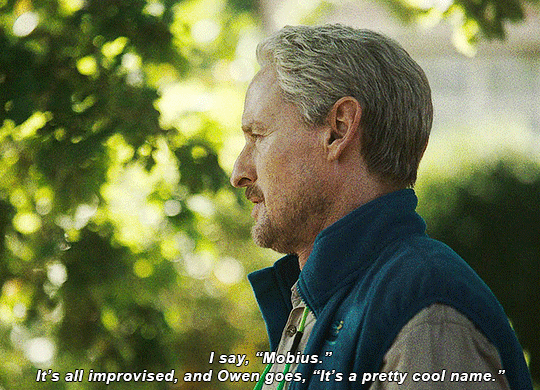
In S2E5, it’s interesting that “good” in this narrative is defined as a heteronormative fantasy of a house, two kids, and (possibly) a puppy and a snake. The “good” in Mobius’s original timeline, however, is imperfect. There is a partner that is missing (partners being a recurring theme in the series, particularly in S2E3), pronounced gone not once but twice. The entire scene between Don and Loki has been discussed at length by many, so there’s no need to reiterate it here. However, let’s bring our attention to Mobius’s avoidance of this “good” because this avoidance resonates with another queer experience.
The TVA, for Mobius, is the place where he studied, saved, and developed a close relationship with Loki. The fear of the “something good” is the fear of being confronted with something Mobius “should” want more than the TVA, and therefore “should” want more Loki. The fear is wanting something (or feeling pressured to want something) other than a queer relationship with no children. The question of “choice” is impacted by what is considered the “norm”.
S2E5 very pointedly focuses on the concern of choice, especially Mobius’s choice, in the bar scene between Loki and Sylvie. “Mobius should get a choice now, no?” At this point, Loki’s regard for Mobius has finally caught up with the romantic nature of Mobius’s feelings for him. And Loki, living his own queer experience, is also afraid of his true desires like Mobius. In being part of the intersectional queer community, the psychological need to guard against disappointment is high and commonplace. Desires are easily disappointed by the expectations of oppressive social mores. This survival tactic manifests itself with our hope and heartbreak with mainstream media, Loki the series being among them.
But Sylvie, the harbinger of true and absolute freedom, takes on the role of supportive ex and challenges Loki to answer Mobius’s question in S1E1: “What do you want?”
In this, Mobius and Loki’s individual relationships with the TVA are identical. It was never about where (the TVA), when (time works differently at the TVA), or why (the timelines). It was about who. It was about each other. The TVA represents a liminal space which became home by virtue of the people who brought love into it. The TVA is code for Loki and Mobius when each speaks of it.
Again, the artists behind the media must self-censure. In this, Loki also self-censures while giving the truth. “I don’t want to be alone. I want my friends back.” It cannot be denied that Mobius is Loki’s first truest and closest friend. “I don’t want to be alone. I want Mobius back.” Sylvie appreciates and validates this desire, but also points out that showing the TVA is something that cannot be unseen. The implication of this response suggests that Sylvie believes that Loki’s friends will feel compelled to join the TVA out of moral pressure. She reiterates the true lives that are being lived, and Loki, loving his friends, loving Mobius, elects to not take that away from them. “You are just fine without the TVA.”
Yet, Loki must choose an act of profound selfless love to save everyone. In doing so, he saves and frees Mobius in the way Mobius saved and freed him. The tragedy and, once again, poetic irony is that they both would have chosen each other. In giving everyone freedom, the true freedom of Loki and Mobius is sacrificed. This double-standard reflects in our reality between those who identify as cis and heterosexual and those who do not.
When Mobius looks at his timeline in S2E6, he does so for one reason: that timeline survived because of Loki’s sacrifice. He must honor that sacrifice and see what Loki protected. Mobius appreciates what he finds, but he doesn’t belong there. It is not what he ultimately longs for. And there must be worry, shame, in recognizing he would prefer to give up the house and two children if a life with Loki were a viable choice.
We all experience loss in our lives. Loss without a goodbye is also commonplace but is another pain that is more acute within the intersectional queer community. I speak of missed opportunities for happiness due to external forces. I speak of loss of self. I speak of loss of friends and family and home. I speak of death, losing a loved one without a goodbye, because same-sex lovers are not considered next of kin, an impossibility without marriage. Marriage echoes back to Don, who has no spouse, and Mobius, who has no partner.
#asks#loki#mobius#lokius#loki season 2#loki series#loki meta#my meta#loki analysis#my analysis#queer community#queer#queer representation#queer relationships#lgbt representation#lgbtq community#lgbtqia
244 notes
·
View notes
Text
Birdwomen
Family: Harpyidae
Birdwomen are the most common of magical creatures, appearing on every continent except for Antarctica*. Opportunistic omnivores, birdwomen take the form of massive carrion birds, typically corvids, vultures, condors and eagles, with the heads of women. They appear to be exclusively female; however, some species such as the Mediterranean harpy (Harpia strophades) do pair up during the mating season, with members impressing prospective partners by inflating a pair of gular sacks at the base of the throat similar to the behaviour of frigatebirds (family Fregatidae) and the greater sage-grouse (Centrocercus urophasianus).
The magic of most species of birdwomen are affiliated with storms and disease. The alkonost (Harpia bilibinae) lays its eggs in the sea, and their hatching causes thunderstorms to form, while the droppings of the Mediterranean harpy immediately befoul food.
While most species are reluctant to directly attack humans, birdwomen have no qualms in consuming carrion. Multiple cultures report birdwomen as constant companions to sites of battle and bloodshed. Nordic myths of Valkyries spiriting away the dead are almost certainly inspired by the sight of Scandinavian species of birdwomen feasting on the bodies of the slain after battle, possibly the crested harpy (Valkyria cristatus), nicknamed by professional harpiers as the "Thor's falcon."
The North American birdwoman (Harpia canadensis) is the largest known species of birdwoman, with species standing between five and six feet tall, with respective wingspans of 12 to 15 feet wide. Easily identified by their black, iridescent plumage, North American birdwomen exhibit an intelligent, often playful and curious personality. While native to western and central Canada and the northwestern United States, one birdwoman was sighted in Point Pleasant, West Virginia through the late 1960s; following the 1967 Silver Bridge collapse, one harpier reported seeing this same birdwoman consuming the bodies of two disappeared travellers who had washed up downriver.
*Sightings of the "penguinwomen" of Antarctica are unsubstantiated and should not be counted as fact.
#harpies#unreality#narrativia#i have spiderwick on the brain and this happened#valkyries#norse mythology#mothman#cryptids
83 notes
·
View notes
Text
so i was watching Fit's stream and he was cleaning up a Federation outpost.... what's up with the outpost names huh? long post warning TL;DR at bottom.
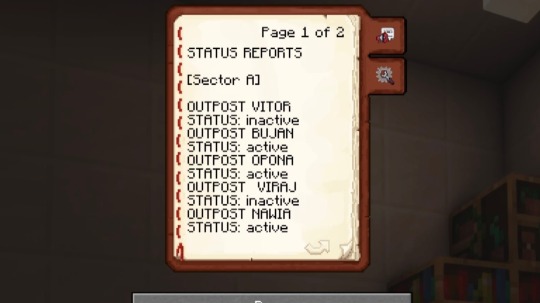
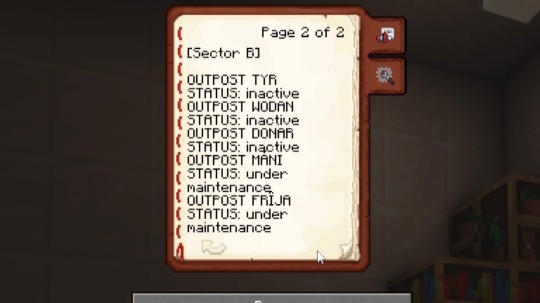
Sector A's outpost names are derived from Slavic mythology; specifically special places from the myths.
after searching these names online i found this website: https://meettheslavs.com/slavic-mythological-places/
taking from the website;
1. there's a "mystical mountain of Vitor" that's "built in heaven" and "hard to find because it changes its location as soon as the wind blows in a different direction". it's also said to have dragons living on it (this is the one Fit was sent to for repairs, and it also had weird blue draconic-looking creatures around it. it was also an icy mountain...)
2. there's a "Buyan/Bujan Island", described to "appear and disappear with the tides" and be the "dwelling place of three brothers, the Northern, Western and Eastern winds".
3. there's a "Kingdom of Opona", an "imaginary place [that] existed at the edge of the Earth which [ancient Russians] imagined as a flat plane." it was believed "free and happy [peasants]" lived in this country under a "true and just" ruler.
4. there's a "Vyraj/Viraj", a "resting place for the souls and spirits" AKA the equivalent of Heaven in Slavic mythology. it's "a place where birds find their retreat in the winter". (notably this outpost is inactive)
5. lastly there's a "Nav/Nawia", a "mysterious place for the souls of the dead", and "often interpreted as another version of the imaginary place Vyraj", so AKA Hell or the Underworld. (the Hell outpost is active but not the Heaven outpost???)
If Outpost Vitor sort of matches the description from the myth, maybe the other outposts do too? so like Bujan is on an island in the sea, Opona is super far out in a village maybe, Viraj and Nawia i have no clue...
Sector B's outpost names are derived from Norse mythology; specifically Norse gods. being a nerd i noticed this instantly which was what tipped me off to search up Sector A's names.
taking from various sources, but mostly from their Wikipedia articles:
1. "Tyr" is an one-armed god representing justice and fair treaties despite being a god of war, who lost his arm in the process of binding Fenrir the wolf. he dies in Ragnarök.
2. "Odin/Woden/Wodan" is the ruler of Asgard, the All-Father, and the one-eyed god of wisdom war, and death. he presided over Valhalla, a sacred hall that housed dead warriors in preparation for Ragnarok. he dies in Ragnarök.
3. "Thor/Donar" is probably the most popular Norse god, the god of thunder. the embodiment of strength, he is the protector of the Æsir and the humans. he dies in Ragnarök.
4. "Máni" is the god of the Moon and brother of Sol, the goddess of the Sun. they is eternally chased by Skoll and Hati, two wolves who seek to plunge the world into chaos by eating the Sun and Moon. he dies in Ragnarök.
5. Outpost Frïja I believe is "Frigg", the Queen of Asgard and the goddess of marriage, family and motherhood. she lives in Ragnarök.
notably, all five gods (and goddess) lend their names to days of the week (Máni -> Monday, Tyr -> Tuesday, Woden -> Wednesday, Thor -> Thursday, and Frigg -> Friday). none of these outposts are active, they are all inactive or under maintenance, so i'm inclined to believe these aren't as important right now as compared to Sector A...
still, these outposts are named after Slavic and Norse myths for a reason possibly so these might be significant. Nothing particularly comes to mind but if anyone has any idea feel free to add on...
TL;DR: Federation Outpost names from Fit's stream have Slavic/Norse mythology inspired names, possible significance?
255 notes
·
View notes
Text
Some fun facts from the Night at The Museum book
I assume this book is based on the original script of the movie so some of these may not be canon to the movies
• there are beetles on exhibit
• larry dropped out of college
• larry has a criminal record from a workplace mishap
• larry found rexy while he was headed to the bathroom
• the museum covers dental
•the western diorama is actually Utah
• it’s confirmed that Jedediah is indeed Jedediah Strong Smith
• the museum is dedicated to Teddy Roosevelt
• larry has never had a job for more than 4 months
• nicky is 10 in the first movie
• rebecca understands hieroglyphics and has tried to figure out the tablet before
• larry doesn’t understand metaphors
• larry hates the feeling of ties around his neck
• the key Reginald copied was larry’s house key
• larry uses the stockade as a threat against octavius
• Larry literally gives jedediah and octavius marriage counseling
• octavius and presumably the other dioramas have two conflicting thoughts, their own, and the ones of the people they are models of
• larry hates asking for help
• teddy interchanges pretty and handsome and does not care about the gender of who he’s complimenting
• larry can’t understand tone
• the tablet talks when it comes alive and says “Thor. Horus. Ra.”
• ahkmenesh was gagged inside his coffin
• the whale in the ocean exhibit is female
• the miniatures ended up flattening all 4 tires
• lewis and clark make it on the bus and do not come back, explaining their absence in the other films
•some of the exhibits feel both cold and pain but others do not
• ahkmenrah can’t read
• larry skipped class a lot
• the ending dance party scene takes place a year after the night they saved the tablet
962 notes
·
View notes
Note
How abt a friendly handshake as a nod to loki that is also funny? (Talking abt a new thor 4 clip)
there is nothing there indicating it is a nod to Loki, or that it is not complete improv on all parts
#i actually found the from midgardian handshake to asgardian handshake thing mildly irritating after the asgardians don't hug thing#and people on earth DO use the 'asgardian handshake' i'm just presuming the western places don't so much#Thor 4
6 notes
·
View notes
Text
It peeves me a little when artists portray Luo Binghe as this massive hulking shitbrick house of a man when in text it's explicitly stated that he's so so pretty in a way that's almost feminine, that if he didn't have Tianlang-jun's eyes he'd be a perfect copy of Su Xiyan. Luo Binghe is tall yes, but he's beautiful in a delicate way. He is literally a pretty boy. He could pull a Thor and pass as a bride to deceive his enemies (og lbh wouldn't do it, but bingmei totally would). Airplane admitted he made him that way because that's what was popular with women.
I do take into account that Binghe's appearance in fanart is clearly influenced by the official western release book illustrations, which portray a Luo Binghe with brown and curly hair, very different from the novel's description. (And yeah it is cute. )
I imagine the western fandom depiction of Binghe is also influenced by the most common views and portrayals of demons of the western world, as barely human looking creatures. And that's why sometimes he is drawn not only massive, but also with horns and fangs and such.
#svsss#luo binghe#just look at donghua binghe. his design is pretty accurate#art style has a lot to do with it too#this post was edited btw if you see it rebloged somewhere else#og version had a couple of paragraphs meant to assure people there wasnt anything bad about their lbh that this was my personal opinion#but I feel like it wasn't necessary because this IS about my own personal humble opinion so *shrugs*#bishonen lbh supremacy
67 notes
·
View notes
Text
Starting in the spring of 2022, I began a magickal process known as the Abremalin Operation. It involves several months of prolonged solitude, which I spent in an abandoned house. I spent hours daily in deep meditation, and experienced profound personality changes and prolonged visions of deities and spirits. I also saw and heard UFOs, experienced poltergeist phenomena, and early on had strange episodes of sleep paralysis. My dreams have always been abnormally lucid and vivid, but I began to have an increase in premonitions (for example, I dreamed in April 2022 that on July 23, 2022 there would be an important party, and it turned out to be my friend's birthday, unbeknownst to me, as well as the first day that Sirius rises behind the sun, which was a festival in ancient Egypt, according to Robert Anton Wilson.)
I stayed in the house alone without power, from late April of 2022, until December of that year. In December you guys helped us turn the power on, and my roommates/cousins Jay Bird and Kenny moved in. By then I was deep in the ritual, and I knew the process was completed because I had to leave my home to begin the wandering phase of my life which I am currently in. After a Rong show in late April 2023 (which is a group ritual to honor Eris) I left for New England in early May.
Perhaps it would have been better to have documented my experiences as they happened in a journal, which all the western magicians recommend. However, I was so sure I would fail that I announced my plans to no one, and I didn't want the embarrassment of a catalogue of my failure. I also reasoned that the great medicine men of old in my tribe didn't even have pens or paper, and they did just fine.
I had visions of many spirits or deities, not all of them I could actually relate (most of them were incomprehensible, although they did change me profoundly, in a way that's impossible to describe.) Once while deep in meditation, I was visited by a six foot long king snake (I documented that here on this blog.)
I made invocations to Eris, Odin, Freya, Bastet, Thor, Dionysus, the panther, Baphomet, and Timothy Leary.
My clearest visions during the process were of Eris, Odin, Thor, Dr. Leary, and Aphrodite (who I didn't invoke, she came during a ritual dedicated to Odin.) These were experiences where I recieved a clear message and saw clear images of other realities. I still occaisionally have visions like these. During a vision while I was performing the operation, during a ritual to honor the panther, I recieved memories from another lifetime before mine, of someone who died in 1955. This was the last signal I recieved before the operation was completed.
31 notes
·
View notes
Text
Been wanting to scream about this for a while now, figured now is a good as ever time to do so.
So Gundam: Witch From Mercury really leans heavily into the whole witches and witchcraft theme, which is interesting for a sci-fi show. Not to say that they don't do it gloriously tho and in this post I will be pointing towards some of the symbolism that I noticed in the show.
The series starts with the first witch we see inside a Gundam Mobile Suit, none other then our dearest Elnora Samaya, also now known as Prospera Mercury. During the prologue, before anything else, we see her and once she exists the dark of the cockpit its revealed that she has fiery, blood red hair.


(Source: prologue G-witch)
Historically, witchcraft has been associated with red heads because of the many prejeduces against them. Red heads are a minority who have been associated with a lot interesting figure, from Judas who betrayed Jesus to the depictions of Lilith. This has given redheads a negative connotations in the Western World.
Next we see that the head researcher leading this project on GUND-format is also a woman, an older woman at that. Dr Cardo Nabo is the visionary leading this project, dedicated to the cause of making the GUND-format work in conjunction with humanity, in order to improve their lives and perserve their future. She knows that humanity, if it wishes to expand further into space and continuenits next steps into exploration and living outside of Earth, will need technology in order to aid their bodies in order to survive and thrive.
Older women involved in a form of medicine is an other motif in witchcraft and witch stereotypes. Witches were often involved in medicine and care. Cardo is the italian way of refering to a thistle, a purple green prickly flower that was said tp have medicinal properties in the middle ages.
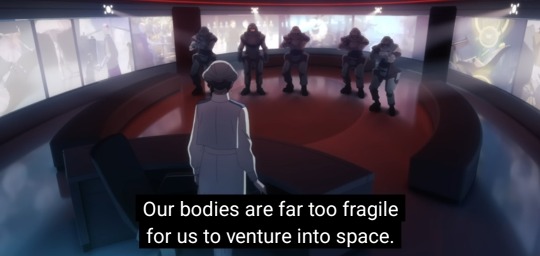

(Source: Prologue G-witch)
During this prologue and later in the show it is revealed that the reason why the Vanadis Institute, of which Dr. Nabo was the head of, was doing resesrch into the GUND-format in conjunction with Mobile Suits because that was the primary way to get access to money for further research. Military funding through Ochs-Earth, an Earthian military company, would allow the Institute to further their goals and to show the viability of the GUND-format.
However, they encountered difficulties during their research. Mobile Suits are far larger and more difficult to control then prostethic limbs. The higher the permet score used by an individual to control more of the suit, the more the chance of death grows. Anything higher then score 3 caused deaths to the user because of, presumably, a data overload caused by the Permet link.
This caused a lot of ethical debates and strife, presumably, where the GUND-format was cast into a dangerous and even inhuman light because of its potential to not just kill others but also the users themselves. This led to the eventual forceful suspension of the project by the council, during which Cathedra used the Dominicus Forces to attack and kill all those present on Fólkvangr, the asteroid where the Vanadis Institute was located. Those present on Fólkvangr were both staff of the institute as well as their family. Everyone who was involved or related to the development of the GUND-format were killed in what is essentially a witch hunt.
Fólkvangr is an other reference to witchcraft, as in Norse Mythology this is a heavenly field in the afterlife ruled over by Freyja, a goddess of many things including magic (to see and influence the future). An other name for Freyja is Vanadís. Once again, this is a reference to paganism and witchcraft within the G-Witch universe thats quite obvious. Ochs also may or may not be a reference to the Old English word for "Oak" (not too sure about that one), if this is indeed true then this may be a reference to Thor, god of Thunder and Lightening as well as a warrior. I considered connecting oaks to Yggdrasil, the world tree, but that is an Ash tree, not an oak.
During the discussion in which the Mobile Suit council werebdeciding the fate of further development of Gundam Mobile Suits, Delling came forth and said that they had to "Wield the hammer of witches" in order to put a stop to the development of Gundams. The "hammer of the witches" is a reference to the Malleus Maleficarum, a 15th century guide on hunting and persecuting witches.
During his speech at the conference, he also calls the fact that gundams kill not only other soldiers but also their wielders a curse, once again a reference to witches. Prior to saying this he also says however that humans should kill humans, instead of humans being killed by just technology (really simplifying this) but essentially what he is saying is that the Gundams killing their wielders is unnatural and goes against the normal way of things.

(Source: Prologue G-witch)
The irony of this is also the name of these organisations. Cathedra is a literal reference to the throne upon which a bishop sits, Dominicus means "of the Lord/Lord's". Both are a reference towards christianity and its opposition to both withcraft and paganism.
Now we have established whom exactly this show calls "Witches", these are the people involved in the manufacturing, research, development and piloting of the GUND-format and Mobile Suits using said format, be it for medicinal or war uses. If you are associated or sympathize with the use of this technology, you are considered "a witch".
Putting this into context, we can now also look at the name "Witch From Mercury". Who does this refer to? I've seen people argue that this might be Aerial or Prospera, but I sincerely disagree. As of the knowledge we have come to learn of in both the short novel as well as everything from episode 16/season 2 episode 4 onwards, we can assume that Suletta was the only one actually raised on Mercury and who feels any connection to the planet at all. Suletta, as both a pilot of a Mobile Suit using the GUND-format as well as the daughter of a witch (Elnora/Prospera), is a witch.
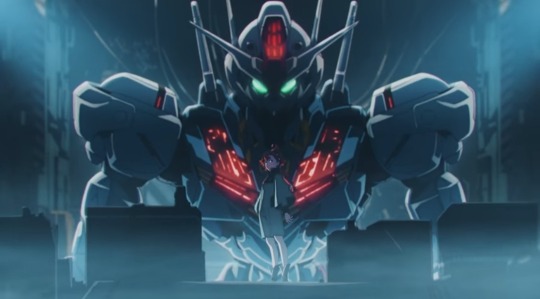
(Source: G-witch teaser announcement)
Now onto my FAVOURITE part: the 2nd ED Red Birthmark. Oh boi this baby has some of the more blatant witch references, I absolutely love it ngl. Starting with the name itself, historically one of the methods to hunt for witches was to check for birthmarks/skin marks. Having strange birthmarkings or an insensitive patch of skin was basically proof enough of you being a witch, again a part of the witch hunt theme.
The song, which I am convinced is from Miorine's perspective (tho maybe/perhaps Aerial, tho thats a small maybe), makes references to seeing into the future, not liking whats in it and changing destiny yourself. Once again, these are themes of clairvoyance, the sort of magic Freyja is associated with (aka Vanadís). Witches were often said to be able to look into the future and change things as well.
Next we have the visual parts if the ED. I'm sure we all ate utterly in love with.
youtube
From 0:44 to 1:00 we have this beautiful sequence of Suletta dancing and conducting GUN-bits.
First Suletta creates a stylized version of the Triple Goddess Symbol, a well known pagan icon amongst both witchcraft practitioners as well as wiccans. The symbol contains 3 moons in different phases; waxing, full and waning. The symbol represents the 3 phases of the goddess; the maiden, the mother and the crone. This is both the life lifecycle of a girl as well as the eay that wisdom is often bestowed upon a person, from the elderly to the adults to the children. You could even argue that this could represent Dr. Nabo, Elnora/Prospera and Suletta.


(Source: G-witch 2nd ED)
Following this we have 5 Suletta's dancing together in which one can assume is a circle dance. Circle dances bave historically been associated with both witches, pagans and cultists. Something ritualistic.

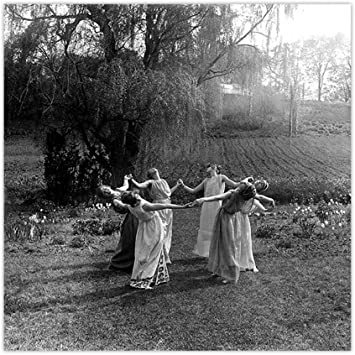
Anyway I'm tired now but there are like way more witchcraft references in the whole show that I can't get into right now cause I'm tired lmao. Anyway have fun with the above, peace.
#Youtube#g witch#gundam: the witch from mercury#suletta mercury#cardo nabo#lady prospera#prospera mercury#elnora samaya#witchcraft#paganism#norse mythology#witch hunt#anime analysis#red heads
109 notes
·
View notes